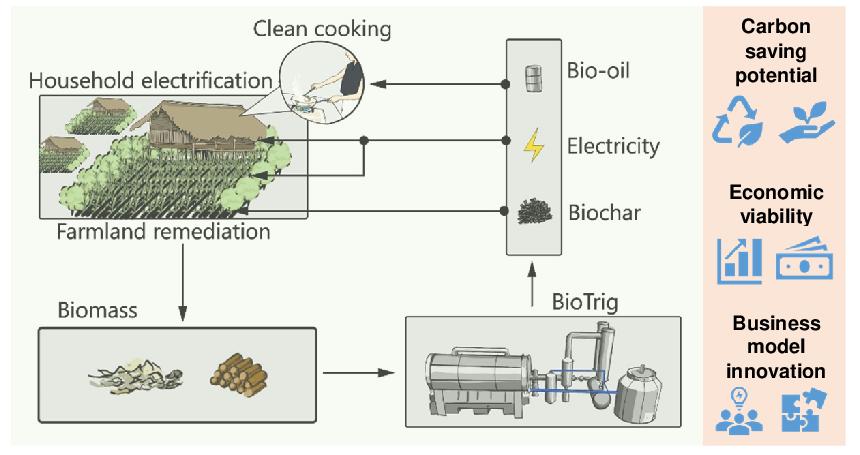Pyrolysis Technology Demonstrates Potential to Enhance Rural Life in India, Reveals New Study
A new approach to waste management could help villages in rural India cut indoor air pollution, improve soil health, and generate clean power, researchers say.
An international collaboration of academics has produced a detailed breakdown of how a process called pyrolysis could turn biomass waste like rice straw, manure and wood into a solution for three common problems at once.
Pyrolysis is a kind of chemical recycling that turns leftover organic materials into their component molecules. It works by sealing the waste inside an oxygen-free chamber and heating it to more than 400 °C, producing useful chemicals in the process.
In a new paper published in the journal Science of the Total Environment, the researchers outline how three products of pyrolysis – bio-oil, syngas and biochar fertiliser – could help villagers live healthier and greener lives with more productive farmland. The paper also lays out a series of recommendations for maximising the system’s economic viability.

The project began with a survey of nearly 1,200 rural households across the Odisha region of India, investigating their experiences of cooking, powering their homes, and farming.
More than 80% of those surveyed wanted to switch from cooking indoors with smoke-producing coal to cleaner options, and access to reliable grid electricity was a priority for almost all respondents. Around 90% said they would be willing to sell agricultural waste to support bioenergy.
The feedback helped inform the team’s design for what they called ‘BioTRIG’, a community-level pyrolysis system which would run on villagers’ waste and provide a series of benefits for rural communities who live below the poverty line.
The syngas and bio-oil would help heat and power the pyrolosis system in future cycles, with surplus electricity used to power local homes and businesses. The clean-burning bio-oil could also be used to replace dirty cooking fuels in homes, and biochar could be used to store carbon while improving soil fertility.
Computer simulations of how effective the BioTRIG system could be in real-world applications showed that it could help drop greenhouse gas emissions from communities by nearly 350 kg of CO2-eq per capita per annum.
Dr Siming You, of the University of Glasgow’s James Watt School of Engineering, leads the research project. He said: “Indoor air pollution is a serious issue in rural India, where cooking with fossil fuels in unventilated residences disproportionately affects the health of women and children. These communities are also faced with the degradation of arable land from unsustainable farming practices, and access to reliable electricity is an ongoing challenge.
“All these problems have been identified by the UN as targets for international sustainable development goals, and the Indian government has already taken steps to begin addressing them across the country.
“The BioTRIG system has the potential to help address all of these serious problems with a trigeneration approach to turning otherwise unusable waste into three useful sources of bioenergy. Scaled across a nation the size of India, even a modest uptake of the system could have a big impact on climate emissions and public health.”
The team’s modelling did show that the BioTRIG system would not be able to support itself financially in the early stages due to high upfront costs. However, the paper also looks at potential business models which could mitigate the initial expense.
Professor Jillian Gordon, of the University of Glasgow’s Adam Smith Business School, is a co-author of the paper. She said: “Two new circular business models could help smooth the transition to widespread BioTRIG adoption. In one scenario, a private sector partner could provide seed funding to set up the pyrolysis units in exchange for social benefits, creating jobs by training local teams to run operation.
“An alternative could reduce costs by asking villagers to contribute their waste feedstocks for free, in return for free biochar and discounted bio-oil that saves them money.
“We hope that breaking down the climate, health and agriculture impacts along with the economic potential in the same paper will help make BioTRIG a project that governments, funders and NGOs will take a close look at to evaluate the benefits it could bring to the half-billion people living across rural India.”
The team’s paper, titled ‘Trigeneration based on the pyrolysis of rural waste in India: Environmental impact, economic feasibility and business model innovation’, is published in Science of the Total Environment.
The collaborative organisations include the University of Glasgow (UK), Gram Utthan (India), CSIR-Indian Institute of Toxicology Research, CSIR-Indian Institute of Petroleum, University of Petroleum and Energy Studies (India), and the University of Queensland (Australia).
The research was supported by funding from the University of Glasgow and Scottish Funding Council’s Global Challenges Research Fund, and the Engineering and Physical Sciences Research Council (EPSRC). The authors appreciate Mr. Leiyu Tian’s help in developing the system diagram.

